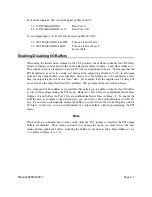
Page 5-3
Manual 00650-529-1
SETUP.EXE
This program is supplied in the root or base directory as a tool for you to use in configuring
jumpers on the card. It is menu-driven and provides pictures of the card on the computer monitor.
You make simple keystrokes to select functions. The picture on the monitor then changes to show
how the jumper should be placed to effect your choices.
The setup program is a stand-alone program that can be run at any time. It does not require that
the card be plugged into the computer for any part of the setup. The program is self-explanatory
with operation instructions and on-line help.
To run this program, at the DOS prompt, enter SETUP.EXE followed by
K
.
VisualBASIC Utility Driver
Extensions to the VisualBASIC 3.0 language are also included on the diskette provided with your
card. (For later versions of VisualBASIC, use the ACCES32 driver and samples.) The extensions
are in a directory named VBACCES. These extensions are in the form of a .DLL, a .GBL, and a
VisualBASIC sample. Together these files allow you to access the port and main memory space in
a fashion similar to BASIC, QuickBASIC, Pascal, C/C++, Assembly, and most other standard
languages.
To use these files in a VisualBASIC program, you must create a .MAK file (File l New Project)
similar to the sample provided (or else, modify your existing project file) and include the .GBL file
(File | Add File). Once this has been done, VisualBASIC will be enhanced with the addition of the
following functions.
InPortb
Function:
Reads a byte from a hardware port. Due to limitations of VisualBASIC, the
number is returned in an integer.
Declaration:
function InPortb(byval address as integer) as integer
InPort
Function:
Reads an integer from a hardware port. This function returns the 16-bit value
obtained from reading the low byte from address and the high byte from
1.
Declaration:
function InPort(byval address as integer) as integer
OutPortb
Function:
Writes the lower eight bits of value to the hardware port at address. This function
returns the value output.
Declaration:
function OutPortb(byval address as integer, byval
value as integer) as integer

























